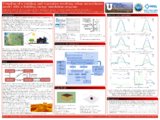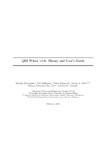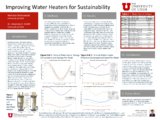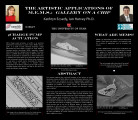|
|
Creator | Title | Description | Subject | Date |
| 1 |
 |
Tran, Thomas T.D. | Thermoeconomic analysis of residential rooftop photovoltaic systems with integrated energy storage and resulting impacts on electrical distribution networks | This paper investigates residential rooftop photovoltaic (PV) systems for long-term thermoeconomic benefits from PV homeowners' perspectives and for impacts on the electrical distribution network from grid operators' perspectives. The costs of generating electricity from grid-connected PV systems ar... | Rooftop PV; Net Metering; Distribution Network; Energy storage; LCOE | 2018-07-07 |
| 2 |
 |
Smith, Amanda D. | Modeling two-phase flow and vapor cycles using the generalized fluid system simulation program | This work presents three new applications for the general purpose fluid network solver code GFSSP developed at NASA's Marshall Space Flight Center: (1) cooling tower, (2) vapor-compression refrigeration system, and (3) vapor-expansion power generation system. These systems are widely used across eng... | Modeling; Fluid systems; Cooling tower; Vapor compression refrigeration, vapor power cycle | 2017-09 |
| 3 |
 |
Thomas, Tran T. D. | Evaluation of renewable energy technologies and their potential for technical integration and cost-effective use within the U.S. energy sector | Energy demands, environmental impacts of energy conversion, and the depletion of fossil; fuels are constant topics of discussion in the energy industry. Renewable energy technologies; have been proposed for many years to address these concerns. However, the transformation; from traditional methods o... | Renewable energy; Power generation; Electrical grid; Emerging energy systems; System integration | 2017-07 |
| 4 |
 |
Tran, Thomas T. D. | System scaling approach and thermoeconomic analysis of a pressure retarded osmosis system for power production with hypersaline draw solution: A Great Salt Lake study | Osmotic power with pressure retarded osmosis (PRO) is an emerging renewable energy option for locations where fresh water and salt water mix. Energy can be recovered from the salinity gradient between the solutions. This study provides a comprehensive feasibility analysis for a PRO power plant in a ... | Pressure retarded osmosis; Power generation; Renewable energy; Hydroelectric; Levelized cost | 2017-06 |
| 5 |
 |
Legorburu, Gabriel | Energy modeling framework for optimizing heat recovery in a seasonal food processing facility | Societal, cultural and economic factors are driving food processors to reduce energy consumed per unit mass of food. This presents a unique problem because time variant batch processing using low to medium grade heat is common in food production facilities. Heat recovery methods may be implemented b... | Energy efficiency; Food industry; Heat recovery; Optimization; Simulation | 2018-07-20 |
| 6 |
 |
Tran, Thomas T.D. | Incorporating performance-based global sensitivity and uncertainty analysis into LCOE calculations for emerging renewable energy technologies | Assessing system costs for power generation is essential for evaluating the economical aspect of energy resources. This paper examines traditional and renewable energy resources under uncertainty and variability of input variables. The levelized cost of electricity (LCOE) of each technology is compu... | Renewable energy technologies; LCOE levelized cost of electricity | 2018-02-14 |
| 7 |
 |
Legorburu, Gabriel | Using Observed Data During Early Design To Simulate Building Mechanical System Energy Performance | | Energy Modeling; Real-World Data; Neural Networks | 2019 |
| 8 |
 |
Didier, Richard C. | Linking microclimate and energy use with a low cost wall mounted measurement system | Urban microclimate plays a critical role in overall urban energy demand and efficiency. At the building scale, energy use and internal conditions are directly impacted by local microclimate. The direct link between building energy use and local microclimate is through building envelope heat fluxes. ... | Microclimate; Energy; Temperature; Humidity; Arduino; EnergyPlus | 2016-06 |
| 9 |
 |
Rahman, Aowabin | Deep recurrent neural networks for building energy prediction | This poster illustrates the development of a deep recurrent neural network (RNN) model using long-short-term memory (LSTM) cells to predict energy consumption in buildings at one-hour time resolution over medium-to-long term time horizons ( greater than or equal to 1 week). | Machine learning; Energy; Building energy modeling; Deep learning; Recurrent neural networks; Prediction | 2017-01-13 |
| 10 |
 |
Rahman, Aowabin | Predicting electricity consumption for commercial and residential buildings using deep recurrent neural networks | This paper presents a recurrent neural network model to make medium-to-long term predictions, i.e. time horizon of ≥ 1 week, of electricity consumption profiles in commercial and residential buildings at one-hour resolution. Residential and commercial buildings are responsible for a significant fr... | Building Energy Modeling; Machine learning; Recurrent neural networks; Deep learning; Electric load prediction | 2017 |
| 11 |
 |
Bianchi, Carlo | Energy demands for commercial buildings with climate variability based on emission scenarios | The impacts of a changing climate are wide-ranging in both impact and scope. This paper investigates the effect that realistic climate variability would have on building energy demands in Salt Lake City, UT to inform planning for air quality impacts. Energy demand scenarios were derived using climat... | BEM; EnergyPlus; Emissions; Climate; Energy | 2017 |
| 12 |
 |
Bianchi, Carlo | Coupling of building and vegetation resolving urban microclimate model with a building energy simulation program | The objective of this work is to develop and validate a coupled fast-running Building Energy Modeling/Microclimate model for use in developing site-specific design strategies which minimize energy and water use All the micro-climate variables affecting the building energy consumption, such as solar ... | Building energy modeling; Urban; Microclimate; Simulation; Energy; Environment | 2018-08 |
| 13 |
 |
Rahman, Aowabin | Predicting fuel consumption for commercial building with machine learning algorithms | This paper presents a modeling framework that uses machine learning algorithms to make longterm, i.e. one year-ahead predictions, of fuel consumption in multiple types of commercial prototype buildings at one-hour resolutions. Weather and schedule variables were used as model inputs, and the hourly ... | Building energy modeling; Machine learning; Prediction; Heating load; Data-driven modeling | 2017-08 |
| 14 |
 |
Rahman, Aowabin | Predicting heating demand and sizing a stratified thermal storage tank using deep learning algorithms | This paper evaluates the performance of deep recurrent neural networks in predicting heating demand for a commercial building over a medium-to-long term time horizon (≥ 1 week), and proposes a modeling framework to demonstrate how these longer-term predictions can be used to aid design of a strati... | Building Energy Modeling; Machine Learning; Recurrent Neural Networks; Deep Learning; Heating Load Prediction; Thermal Energy Storage | 2018 |
| 15 |
 |
Bozorgmehr, Behnam | QES-Winds v1.0: Theory and User's Guide | A new dispersion modeling system based on the well-used FORTRAN-based QUIC (Quick Urban and Industrial Complex) dispersion modeling system originally developed by the University of Utah and Los Alamos National Laboratory [1], has been under development as collaboration between the University of Utah... | | 2021 |
| 16 |
 |
Malinowski, Nicholas | Improving water heaters for sustainability | Buildings use about 40% of the total U.S. energy demand. Water heaters provide hot water for a variety of building uses including sinks, showers, dishwashers, washing machines, and space heating. Water heaters are the second most energy intensive appliances in a common household. Typically a home... | Water heaters; Energy efficiency; Electricity; Emissions; Natural gas | 2018 |
| 17 |
 |
Normann, Richard A.; Abbasi, Masoud; Johansson,Torbjorn | Silicon carbide enhanced thermomigration | The widespread acceptance of thermomigration technology to produce through-chip interconnects has been impaired by (i) a random walk of the Si-Al liquid eutectic inclusion as it traverses the wafer, and (ii) a ?surface barrier? which allows thermomigration of only relatively large inclusions. In ... | Silicon Dioxide; Thermometers; Transducers; Thermomigration Technology; Infrared Lamps | 1992 |
| 18 |
 |
Normann, Richard A.; Johansson,Torbjorn; Abbasi, Masoud; Huber, Robert J. | Three-dimensional architecture for a parallel processing photosensing array | A three-dimensional architecture for a photosensing array has been developed. This silicon based architecture consists of a 10 x 10 array of photosensors with 80 microns diameter, through chip interconnects to the back side of a 500 microns thick silicon wafer. Each photosensor consists of a 300 x 3... | Retina; Optics; Silicon; Photosensing | 1992 |
| 19 |
 |
Horch, Kenneth W.; Lawrence, Steve M.; Dhillon, Gurpreet S. | Acute peripheral nerve recording characteristics of polymer-based longitudinal intrafascicular electrodes | We examined the recording characteristics of two different types of polymer-based longitudinal intrafascicular electrodes (LIFEs) in peripheral nerve: single-stranded (s-polyLIFEs) and multistranded (m-polyLIFEs). Recordings were also made from Pt-Ir wire-based electrodes (PtIrLIFEs) as a control. T... | Sciatic Nerve; Intrafascicular Electrodes, Peripheral Nerve Recording | 2004 |
| 20 |
 |
Horch, Kenneth W.; Dhillon, Gurpreet S. | Direct neural sensory feedback and control of a prosthetic arm | Evidence indicates that user acceptance of modern artificial limbs by amputees would be significantly enhanced by a system that provides appropriate, graded, distally referred sensations of touch and joint movement, and that the functionality of limb prostheses would be improved by a more natural co... | Peripheral Nerve Implant; Prosthetic Limb Control; Sensory Feedback | 2005-12 |
| 21 |
 |
Normann, Richard A.; Horch, Kenneth W.; Cha, Kichul | Mobility performance with a pixelized vision system | A visual prosthesis, based on electrical stimulation of the visual cortex, has been suggested as a means for partially restoring functional vision in the blind. The prosthesis would create a pixelized visual sense consisting of punctate spots of light (phosphenes). The present study investigated the... | Visual Prosthesis; Mobility; Phosphene Simulator | 1992 |
| 22 |
 |
Ecsedy, Kathryn Lyn; Harvey, Ian R. | The artistic applications of M.E.M.S.: gallery on a chip | Our research explored the crossroads between art and science to create tiny devices known as MEMS (Micro Electrical Mechanical Systems). These artistic devices are powered by micro charge-pumped actuation of electrons in a scanning electron microscope, utilizing a phenomenon once considered an irri... | Artistic applications; MEMS; Micro Electrical Mechanical Systems; Kinetic micro sculpture; Micro charge pump actuation; Trapeze Interactive Poster | 2010-03-15 |
| 23 |
 |
Ameel, Timothy A | Microchannel fluid behavior using micropolar fluid theory | In this paper, we describe microchannel fluid behavior using a numerical model based on micropolar fluid theory and experimentally verify the model using micromachined channels. The micropolar fluid theory augments the laws of classical continuum mechanics by incorporating the effects of fluid ... | | 1998 |
| 24 |
 |
Ameel, Timothy A; Gale, Bruce K.; Harvey, Ian R. | A three-semester interdisciplinary educational program in microsystems engineering | Motivated by an NSF IGERT grant in the general area of microfluidics, a sequence of three interdisciplinary technical courses has been developed in the emerging area of microsystems engineering. Designed to be taken in series, these courses take students, both graduate and upper-level undergraduates... | | 2004 |
| 25 |
 |
Ameel, Timothy A;Harvey, Ian R.; Miller, Mark S.; Blair, Steven; Gale, Bruce K.; Ring, Terry Arthur | Building academic, research, and commercialization programs in micro and nano science and engineering at the University of Utah | Abstract-This paper presents a case-study of some University /Government / Industry interactions at the University of Utah that build research and academic programs and create opportunities fur economic growth in the areas of micro and nanu science and engineering. | | 2003 |

























